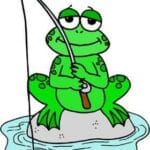LESSON 2.3
Create the What Statement
Grades 7 - Adult

Task 2.3.1 – Individual
We will pretend that “Canaan seeing-eye dog” won the subject selection process in the previous chapter. Your What Statement looks like this:
LH | VP | RH |
Narrator | Verb Phrase | Nonfiction Idea |
|
|
|
Place the word I in the LH slot of the What Statement. Place your chosen idea in the RH slot.
LH | VP | RH |
Narrator | Verb Phrase | Nonfiction Idea |
I |
| Canaan seeing-eye dog |
The What Statement and Communication Barbell are the same thing:
The Word Favorite
If you see the word favorite in a prompt, then insert like or its synonym:
LH | VP | RH |
Narrator | Verb Phrase | Nonfiction Idea |
I | like | ? |
Not like this:
LH | VP | RH |
Narrator | Verb Phrase | Nonfiction Idea |
My favorite ? | is | a(n) |
Creating the What Statement the second way means having the same variable twice in the statement. “My favorite pet” and “a Canaan seeing-eye dog” are the same thing.
Wrong: What is your favorite pet?

Tie Line

Prompt: If you could be any wild animal, what would you be?
If I could be any wild animal, I would be a Canaan seeing-eye dog.
Task 2.3.2 – Individual
Create a What Statement for your idea.
Assessing What Statements
To see if a What Statement is worth discussing, answer these questions:
- Is the What Statement a sentence?
- Are there two variables?
- Is one variable New? (Use the Old/New formula to determine this.)
Sentence
A sentence is something you can say and it sounds okay. If it sounds strange, then it is usually a fragment. A sentence rarely starts with—
although/though
as/as if
because/since
if
in order to/so that
when/while
where/whereas
Variables
A variable is a central idea expressed in the What Statement. They are the ends of the Barbell of Communication Some variables are hidden. We will cover those later.
Old Variable
Old Variables are ones the intended audience likely knows about or does not care about.
New Variable
New Variables are ones the intended audience does not know much about and are likely to interest the intended audience.
Expressed as a flowchart:
Is the What Statement a sentence? | Rewrite. |
Are there two variables? | Re-determine the variables. |
Is at least one variable (or their relationship) New information? | Funnel one or both variables or their relationship, or start over |
The Formula
As you learned in the previous chapter, you can express the effectiveness of a What Statement with this formula:
O + O = poor subject
O + N = good subject
N + O = good subject
Task 2.3.3 – Small Group
Determine if the following What Statements are worth discussing.
- I like ski-joring
- I like collecting stamps
- I like collecting stamps from Pitcairn Island
- I like collecting stamps from Pitcairn Island, home of the Bounty mutineers
- I like basketball
- I like sleeping
- I like making Athabascan slippers
- I like shooting around
- I like shooting free throws
- 10.I like playing HORSE in basketball
- 11.I like sleeping at the sleep disorders center
- 12.I like sleeping beneath the stars.
